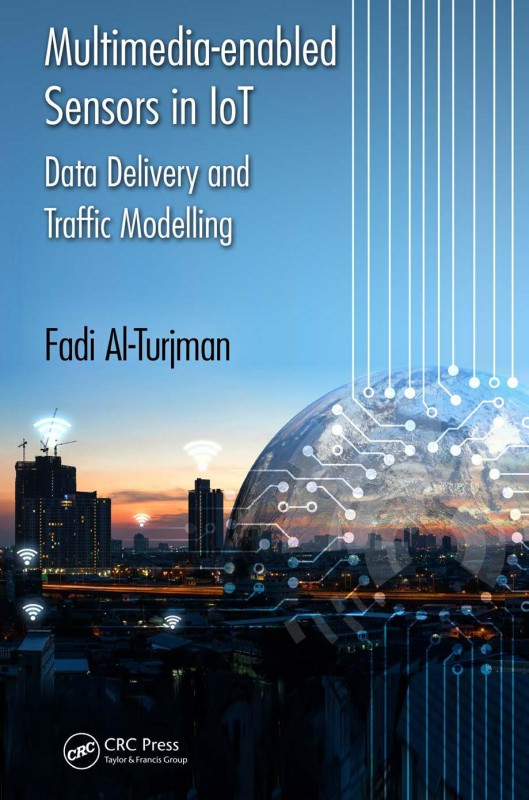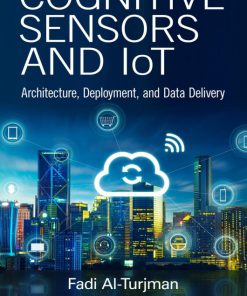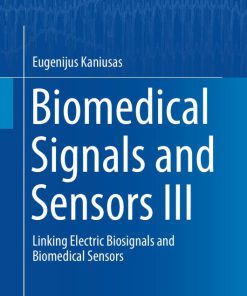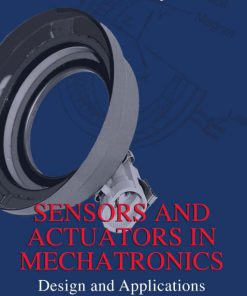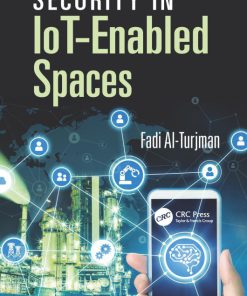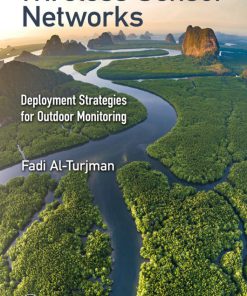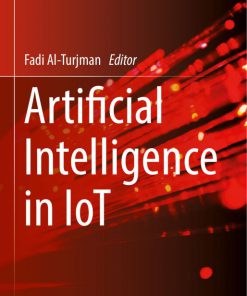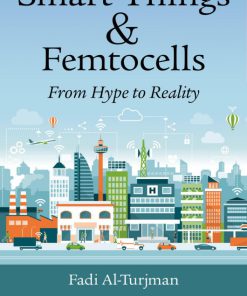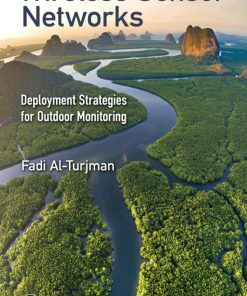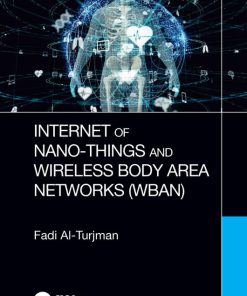(Ebook PDF) Multimedia Enabled Sensors in IoT Data Delivery and Traffic Modelling 1st edition by Fadi Al Turjman 1351166026 9781351166027 full chapters
$50.00 Original price was: $50.00.$25.00Current price is: $25.00.
Authors:Fadi Al-Turjman , Series:Computer Science [10] , Tags:Computers; Information Technology; Networking; General; Technology & Engineering; Mobile & Wireless Communications; Data Delivery and Traffic Modelling , Author sort:Al-Turjman, Fadi , Ids:Google; 9781351166027 , Languages:Languages:eng , Published:Published:Apr 2018 , Publisher:CRC Press , Comments:Comments:This book gives an overview of best effort data and real-time multipath routing protocols in WMSN. It provides results of recent research in design issues affecting the development of strategic multipath routing protocols that support multimedia data traffic in WMSN from an IoT perspective, plus detailed analysis on the appropriate traffic models.
Multimedia-Enabled Sensors in IoT: Data Delivery and Traffic Modelling 1st edition by Fadi Al-Turjman – Ebook PDF Instant Download/DeliveryISBN: 1351166026, 9781351166027
Full download Multimedia-Enabled Sensors in IoT: Data Delivery and Traffic Modelling 1st edition after payment.
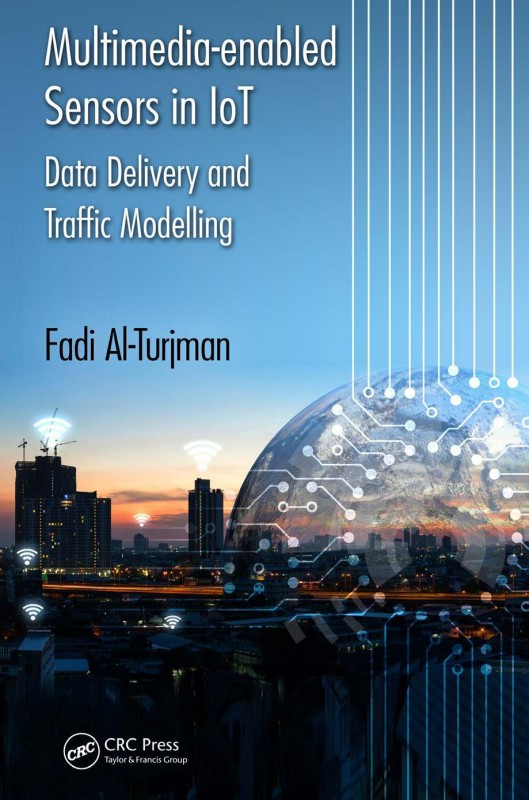
Product details:
ISBN-10 : 1351166026
ISBN-13 : 9781351166027
Author : Fadi Al-Turjman
This book gives an overview of best effort data and real-time multipath routing protocols in WMSN. It provides results of recent research in design issues affecting the development of strategic multipath routing protocols that support multimedia data traffic in WMSN from an IoT perspective, plus detailed analysis on the appropriate traffic models.
Multimedia-Enabled Sensors in IoT: Data Delivery and Traffic Modelling 1st Table of contents:
1. Introduction
1.1 Contributions
1.1.1 Book Outline
References
2. A Survey on Multipath Routing Protocols for QoS Assurances in Real-Time Wireless Multimedia Sensor Networks
2.1 Introduction
2.2 Comparison with Related Survey Articles
2.3 Routing System Architecture and Design Issues
2.3.1 Hard and Soft Real-Time Operation and Best-Effort for Resource Constraints
2.3.1.1 Hard Real-Time (HRT)
2.3.1.2 Soft Real-Time (SRT)
2.3.1.3 Best-Effort (BE)
2.3.2 Energy Efficiency Model
2.3.3 QoS Modeling Requirements
2.3.3.1 Latencies
2.3.3.2 Bandwidth
2.3.4 Sensor Network
2.3.5 Data Delivery Model
2.3.5.1 Continuous Time-Driven Delivery Model
2.3.5.2 Event-Driven and Query-Driven Models
2.3.5.3 Hybrid Model
2.3.6 Dynamic Network
2.3.7 Reliability and Fault Tolerance
2.3.7.1 Local Communication (Node-to-Node)
2.3.7.2 Point-to-Point (Node-Node)
2.3.7.3 Convergence (Node-to-Sink)
2.3.7.4 Divergence (Sink-to-Node)
2.3.8 Summary
2.4 Routing Techniques in WMSNs Classification
2.4.1 Designing Issues for Multipath Routing
2.4.2 The Taxonomy of Multipath Routing Techniques
2.4.3 Summary
2.5 Multipath Routing Protocols: Challenges and Issues
2.5.1 Multipath Discovery
2.5.1.1 Partially Disjoint Paths
2.5.1.2 Braided Multipath
2.5.1.3 Disjoint Paths
2.5.2 Multipath Forwarding Models
2.5.2.1 Path Selection
2.5.2.2 Distribution Traffics Splitting Pattern
2.5.3 Maintenance of Paths
2.5.4 Summary
2.6 Concurrent Multipath Unicast Forwarding
2.6.1 Multipath Multi-QoS Constraints for Efficient Resource Allocation
2.6.1.1 Principal Protocols of Multipath Multi-QoS Constraints
2.6.1.2 Discussion
2.6.2 Multipath Reliability Constraint for Reliable Data Transmission
2.6.2.1 Principal Protocols for Multipath Reliability Constraint
2.6.2.2 Discussion
2.7 Alternative Multipath Broadcast Flooding
2.7.1 Data-Centric Protocol Operation
2.7.2 Data-Centric Protocol Problem
2.7.2.1 Principal Protocols
2.7.2.2 Discussion
2.7.3 On-Demand Fashion
2.7.3.1 DSR Principal Protocols
2.7.3.2 AODV Principal Protocols
2.7.3.3 Proactive Routing
2.7.4 Discussion
2.8 Simulation Comparisons
2.9 Open Research Problems
2.9.1 Data Sensing and Delivery Model
2.9.2 Node Deployment
2.9.3 Node Capabilities
2.9.4 Link Quality Estimators (LQEs)
2.9.5 Mobility
2.9.6 Scalability
2.9.7 Multimedia Content
2.9.8 Energy Efficiency Considerations
2.9.9 Multi-Constrained QoS Guarantee
2.9.10 Cognitive Radio (CR)
2.10 Conclusion
Acknowledgments
References
3. Optimized Multi-Constrained Quality-of-Service Multipath Routing Approach for Multimedia Sensor Networks
3.1 Introduction
3.2 Related Works
3.3 Partitioning Multi-Constrained Multipath Routing (PMMR) Protocol
3.3.1 Problem Formulation
3.3.2 Link Quality Modeling
3.3.3 Neighboring Node-Disjointed Discovery Procedure
3.3.4 Path-Disjointed Discovery Procedure
3.3.5 Path-Disjointed Selection Procedure
3.4 Multi-Constraints QoS Parameters Modeling
3.4.1 Power-Consumption Modeling
3.4.2 Delay-Constraint Modeling
3.5 Performance Evaluation
3.5.1 Experiment 1: Effectiveness of Cut-off Determination
3.5.2 Experiment 2: Comparison against Three Routing Algorithms
3.6 Conclusions
References
4. Green Data Delivery Framework for Safety-Inspired Multimedia in Mobile IoT
4.1 Introduction
4.2 Related Work
4.2.1 Multipath Unicast Forwarding
4.2.1.1 Multipath QoS-Based Protocols
4.2.1.2 Reliability Constraints
4.2.2 Alternative Multipath Broadcasting
4.2.2.1 Data-Centric Approaches
4.2.2.2 On-Demand Approaches
4.3 System Model
4.3.1 Network Architecture
4.3.2 Lifetime and Energy Model
4.3.3 Communication Model
4.4 Multipath Disruption-Tolerant Approach (MDTA)
4.5 Theoretical Analysis on Lifetime
4.6 Performance Evaluation
4.6.1 Performance Metrics and Parameters
4.6.2 Simulation Setup
4.6.3 Simulation Results
4.7 Conclusions
References
5. A Delay-Tolerant Framework for Integrated RSNs in IoT
5.1 Introduction
5.2 Related Work
5.2.1 Architectures for Integrated RSNs
5.2.2 Node Placement in Integrated Architectures
5.2.3 Data Transfer in DTNs
5.3 System Models
5.3.1 Network Model
5.3.2 Delay Model
5.3.3 Communication Model
5.4 Integrated RSN Framework
5.4.1 Optimal Placement of Super Nodes
5.4.2 CN Selection
5.5 Discussion and Results
5.5.1 Simulation Model
5.5.2 Simulation Results
5.6 Conclusion
Acknowledgments
References
6. Multimedia-Enabled WSNs Using UAVs for Safety-Oriented Mobile IoT
6.1 Introduction
6.2 Related Work
6.3 System Model
6.3.1 Problem Formulation
6.3.2 Energy Model
6.3.3 Delay Model
6.3.4 Throughput Model
6.4 Particle Swarm Optimization (PSO) Algorithm
6.5 Performance Evaluation
6.5.1 Simulation Results
6.6 Conclusion
References
7. Evaluation of a Duty-Cycled Asynchronous X-MAC Protocol for VSNs
7.1 Introduction
7.2 Related Works
7.3 Overview of the X-MAC Protocol
7.4 Markov Model of X-MAC
7.4.1 The Hidden-Problem Formulation
7.4.2 Media Access Rules of X-MAC
7.5 QoS Parameters Analysis of the X-MAC Protocol
7.6 Simulation Results
7.6.1 Varying the Cycle Length
7.6.2 Varying the Number of Nodes
7.6.3 Discussion
7.7 Conclusion
7.8 Competing Interests
7.9 Funding
7.10 Author’s Contributions
Acknowledgments
References
8. Mobile Traffic Modeling for Wireless Multimedia Sensor Networks in IoT
8.1 Introduction
8.2 Related Work
8.3 QoS-Based Multimedia Traffic Modeling Framework
8.3.1 Analysis of Retransmission Channel Access Schemes
8.3.2 Modeling Duty-Cycle Node Operations
8.3.3 Energy and Delay Modeling
8.3.4 Throughput Modeling
8.3.5 Path Loss Model
8.3.6 Failure Modeling
8.3.6.1 Coverage Factor
8.3.6.2 Sensor Failure Rate
8.4 Use-Case Transmission Modeling
8.5 Performance Evaluation
8.5.1 Simulation Results
8.5.1.1 The Impact of Radio Irregularity on Energy Consumption
8.5.1.2 The Impact of Radio Irregularity on Average Delay
8.6 Concluding Remarks
References
9. Information-Centric Framework for the IoT: Traffic Modeling and Optimization
9.1 Introduction
9.2 Related Work
9.3 System Models
9.3.1 Network Model
9.3.2 Delay and Disruption Model
9.3.3 Traffic Representation Model
9.3.4 Problem Statement
9.4 CDE-Based Framework
9.5 Real Scenarios and Case Studies
9.6 Simulation Results and Discussions
9.7 Conclusion
References
10. Conclusions and Future Directions
10.1 Summary of the Book
10.1.1 Future Directions
People also search for Multimedia-Enabled Sensors in IoT: Data Delivery and Traffic Modelling 1st:
multi-sensor environment
multi-sensor cameras
multi-domain sensing system
iot sensors with a-d system
iot enabled multi-energy systems
You may also like…
eBook PDF
(Ebook PDF) Artificial intelligence in IoT 1st edition by Fadi AI Turjman 3030041107 9783030041106

